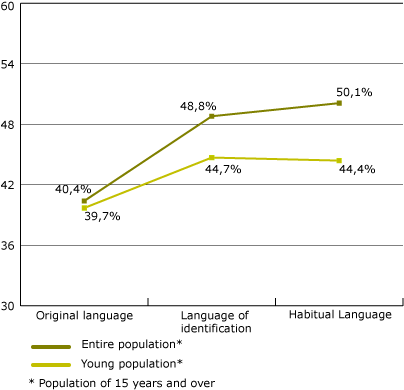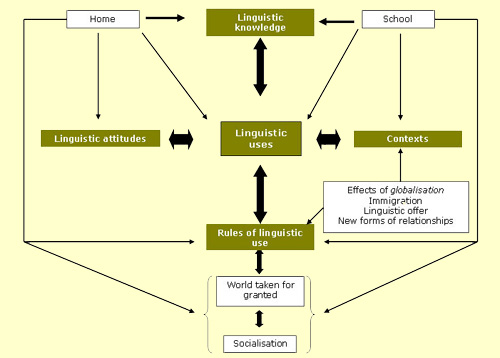
| Winter 2008 |
Sociolinguistic characterisation of young people in Catalonia: some factors that explain linguistic uses, by Anna Torrijos(1) |
||||
This article offers the conclusions of a study on the linguistic uses of young people in Catalonia. The ultimate objective of the study was to view some factors of an explanatory model of the linguistic uses of young Catalan people, taking as a starting point the fact that, despite the high degree of Catalan competence acquired by young people at school, this does not correspond to its use. To do so, we combined qualitative and quantitative techniques using the data obtained in two studies promoted by the Generalitat of Catalonia. the Grups de discussió per a l'avaluació de la campanya "Dóna corda al català" (Discussion groups to evaluate the “Give Catalan a boost” campaign study, promoted by the Secretariat for Linguistic Policy, and the Enquesta als joves de Catalunya 2002 (2002 Survey on young people in Catalonia), promoted by the General Secretariat for Youth). |
|||
Sumari
1. Introduction
2. Methodology and sources
of research information
3. Some factors of the explanatory
model of the linguistic uses of young people
4.The quantitative analysis:
application of the logit model
5.The qualitative analysis:
the discussion groups
6. Conclusions
7. Bibliography
Introduction
The changes to which Catalan society has been subjected over the
last 25 years have enabled new generations of young people and infants
to live normally in Catalan: competence in the Catalan language among
the population aged under 30, according to the data of the census, is
now practically complete. The system of linguistic conjunction in the
education system, which was initiated in 1983, has meant that these generations
have done their schooling integrally in Catalan. Therefore, according
to the data of the linguistic census of Catalonia (2),
the knowledge of Catalan among the population of young people aged between
15 and 29 is much greater than the rest of the population, particularly
with regard to speaking (88.2%), reading (88.8%) and writing (80.5%).
Table 1. Knowledge of Catalan among the population in Catalonia. 2001
| Understand Catalan | Can speak it | Can read it | Can write it | |
| Entire population* | 94,5% | 74,5 | 74,3% | 49,8% |
| Population aged between 15 and 29 | 96,2% | 88,2% | 88,8% | 80,5% |
* Population of 2 years or more
Source: Our own work prepared using data from the 2001 Census, Idescat.
Data from the Statistic of linguistic uses in Catalonia 2003 (EULC 2003) (3) shows how young people aged between 15 and 29 (figure 1) show the same behaviour with regard to their original language (the first one they spoke at home), their language of identification (the one they consider to be "their" language) and their habitual language (the one they usually use) as the general public. Thus, in both cases, there is a lower percentage of people who have Catalan as their first language but this percentage increases when we talk about their own language and increases even more so with regard to the language they habitually use.
Figure 1. Percentage of Catalan as original language, language of identifications and habitual language (1)

(1) The percentages of answers of "only Catalan" are added to those of "more Catalan than Spanish". Source: Statistics of linguistic uses in Catalonia 2003.
In this context, the study tries to make out some of the factors that explain why, despite the high Catalan competence of young people at present, they use it less intensely or less than their abilities. To do so, it centres on the identity and sociodemographic aspects that could explain, in a simplified scheme, some factors that influence the linguistic use of young Catalan people.
2. Methodology and sources of research information
The methodological approach of the study is a multiple one, combining techniques of qualitative and quantitative research.
Quantitative techniques can count individuals and therefore help us have a characterisation of the young society. However, we need to take into account the limits of each technique of exploiting quantitative data. The use of qualitative techniques complements the quantitative information in that it covers matters that cannot be compiled through a survey and explains the numerical information in a discursive way. The qualitative techniques include the spontaneity of the interviews which give rise to realities that were not initially expected. In this study, the quantitative technique was used to view the influence of some variables in the use of Catalan, of Spanish or of both languages. The qualitative analysis analyses the variables that there are in the quantitative analysis and tries to view other factors that influence uses and that do not appear in the quantitative analysis
The data of the survey
With regard to quantitative analysis, we used the Enquesta als joves de Catalunya 2002, promoted by the Secretariat for Youth.(4) This is a periodical survey on the young people of Catalonia, carried out with the aim of getting to know the development of their situation and their life conditions.
This survey takes as its universe the population aged between 15 and 29, residing in Catalonia which represents a total of 1,454,489 people, according to the data of the Statistics of the population of 1996. The interviews were carried out face to face at the home of the person interviewed between May 2nd and July 3rd 2002. The total sample is 2,000 valid interviews. The size of the sample means accepting a margin of error of +/- 2.2 % for the overall data in the case of maximum indetermination (p=q=50) for a confidence level of 95.5%.(5)
In addition, for the analysis of the sociolinguistic context of Catalonia, we also used the data of the 2003 Survey of linguistic uses in Catalonia (EULC 2003).
As far as the specific quantitative analysis techniques are concerned, we did bivariable analyses to be able to achieve the application of a logliniar model, specifically a logit model. Loglinear models are multivariable analysis techniques for qualitative variables that facilitate the study of relationships of the set of variables. They are very useful techniques for analysing the relationships between more than 3 variables, in which one contingency table would be very difficult to interpret. This statistical model summarises and proves hypotheses to thus determine the significance of common association measurements to diverse variables and the influence or effects of one on the other.
The data from the discussion groups
The qualitative analysis was done with four discussion groups of young people aged between 15 and 29 which were done for the study on the evaluation of the "Dóna corda al català" campaign, promoted by the Secretariat for Linguistic Policy.(6) Specifically, in the study explained here, there is an analysis of content of the transcriptions of the four discussion groups with young people, paying special attention to the questions that are of interest to the study.(7)
In a synthetic way, we could say that the discussion groups were meetings of people (participants) who established a conversation on the matter of interest following the directives of the moderator. The participants of the groups did not know each other previously but had specific characteristics concerning the object of the study. As far as the formation of the groups is concerned, it should be mentioned that the discussion groups were designed so that everyone involved in the debate should be represented in them, however, in no case is it representative of what happens with regard to the entire population. We were not looking for a statistical representation, but a typological one.
In this case, the groups were designed according to their linguistic group (Catalan as the habitual language, Spanish as the habitual language or both as the habitual languages), their work situation (students, first jobs or sporadic jobs) and age (15 to 17 years of age, 18 to 22 and 23 to 29). At the same time, intragroup heterogeneity was set up with regard to sex, work situation -in some cases, linguistic group -in other cases. Intragroup heterogeneity is important to set up a framework for the debate, as if it were too homogeneous, group communication would be inhibited.
The groups were recorded on audio or video to make transcribing easier. Therefore, the meetings were held in rooms prepared for this purpose.
3. Some factors that explain young people's linguistic uses
As we have already indicated, this study focused in some sociodemographic, identity and linguistic environment aspects that could explain in a simplified scheme some factors that influence the linguistic uses of young Catalan people. Some factors have already been mentioned by diverse authors.(8) In this sense, the work has tried to view, through two combined techniques, the vitality of the influence of these factors today.
Among the sociodemographic factors included in the analysis are age, place of residence, education level, work situation, the education level of the family nucleus and the family origin. Among the identity aspects (linguistic and non-linguistic ones) we include the language with the family, the language of identification, the rules of socially known linguistic use and linguistic attitudes. With regard to the linguistic environment, we consider cultural consumption and membership of associations, among others. It should be taken into account that some variables considered to be sociodemographic ones also concern the linguistic environment (the place of residence, the work situation) and identity (the family origin among others)
From a sociological perspective, we try to make out how these variables fit in with the historic and social contexts of young Catalan people. Therefore, in the analysis of the quantitative and qualitative data, we reflect on the influence of the social historic situations and other aspects that characterise today's Catalan society such as globalisation processes, immigration and the sociolinguistic situation of the Catalan society.
Below, to show the conclusions of the study in a simplified way, there is a figure whose central feature is the linguistic uses of young Catalan people surrounded by some of the factors that explain these uses. We are aware that this diagram reduces the reality to a simple form of representation and that the social reality is much more complex than is seen here. However, the diagram aims to be an introduction which will be explained throughout the study and its intention is to order the ideas that are discussed later.
Some of the factors that explain the linguistic uses of young people in Catalonia

As you can see in the diagram, this study focuses on the following factors as variables for explaining the linguistic uses of young people in Catalonia: knowledge, contexts, rules of use and linguistic attitudes. Throughout the article, these concepts are explained and their importance in linguistic uses is justified. In addition, it was considered necessary to explain some variables that were taken into account to explain these factors and the way in which they influence linguistic uses. School and home are environments which shape knowledge, attitudes, contexts and rules of use. The socialisation process through which individuals acquire behavioural rules, the governing values in the society in which they live and "the world taken for granted", are other important variables which help to understand current rules of linguistic use.